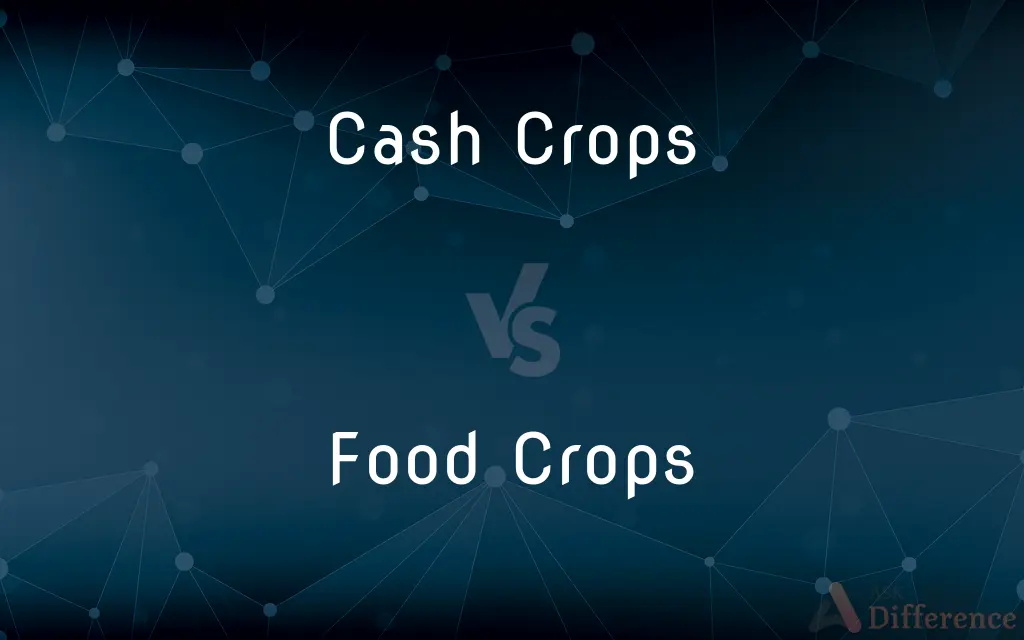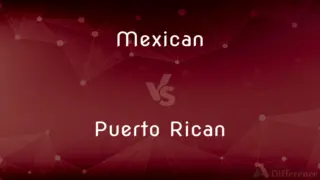Cash Crops vs. Food Crops — What's the Difference?
By Tayyaba Rehman — Published on October 10, 2023
Cash crops are primarily grown for economic profit, whereas food crops are cultivated mainly for human consumption.

Difference Between Cash Crops and Food Crops
Table of Contents
ADVERTISEMENT
Key Differences
Cash crops and food crops serve distinct roles in agricultural and economic systems. Cash crops are primarily cultivated for sale to generate income, usually in the global market, such as cotton, coffee, and rubber. These crops are not primarily grown for sustaining the local population's food needs but are instead intended for trade and export. Conversely, food crops are grown predominantly for consumption, forming the basis of people's diets, like wheat, rice, and vegetables, which are directly utilized to meet the dietary requirements of the population.
Cash crops, being profit-oriented, often demand significant investment and advanced agricultural practices to maximize yield and quality, making them susceptible to market fluctuations and pricing. Food crops, on the other hand, emphasize nutritional value and are essential for survival, with their production often subsidized or supported by government policies to ensure food security and affordability.
The cultivation of cash crops can sometimes lead to monoculture practices, where a single crop dominates the agricultural landscape, potentially impacting biodiversity and ecosystem balance negatively. In contrast, food crops usually encourage diversified farming, promoting ecological balance, and sustainability, as a variety of crops are grown to meet different dietary needs.
Cash crops often require extensive land use and can be resource-intensive, leading to environmental concerns such as deforestation and overuse of water resources. Food crops, though also requiring substantial resources, are generally prioritized due to their role in sustaining life, with their cultivation often regulated to manage environmental impact.
Comparison Chart
Primary Purpose
Grown for economic profit, trade, and export.
Grown primarily for human consumption.
ADVERTISEMENT
Market Focus
Global, subject to market fluctuations.
Local to global, supported by government.
Agricultural Focus
Often involve monoculture and resource-intensive.
Diversified and regulated for sustainability.
Economic Role
Generate income and are profit-oriented.
Essential for survival, focus on nutrition.
Environmental Impact
Can lead to deforestation and overuse of resources.
Cultivation is managed to limit impact.
Compare with Definitions
Cash Crops
Cash crops often require extensive resources and investment.
The cultivation of cash crops like rubber can be resource-intensive.
Food Crops
Food crops are essential for survival and nutrition.
The production of food crops like wheat is crucial for food security.
Cash Crops
Cash crops are grown primarily for sale and profit.
Coffee is one of the most lucrative cash crops in the world.
Food Crops
Food crops are cultivated to meet the dietary needs of populations.
Rice is a staple food crop for a large part of the world’s population.
Cash Crops
Cash crops can lead to monoculture practices.
The focus on lucrative cash crops like cocoa can result in reduced biodiversity.
Food Crops
Food crops are often supported by government policies.
Subsidies are often provided to farmers cultivating food crops like corn to ensure affordability.
Cash Crops
Cash crops are susceptible to market fluctuations and pricing.
The prices of cash crops like tea can vary significantly based on market demand.
Food Crops
Food crops can be both locally consumed and exported.
Many countries cultivate food crops like potatoes for both domestic consumption and export.
Cash Crops
Cash crops are usually intended for the global market.
Cotton, as a cash crop, has a significant presence in international trade.
Food Crops
Food crops usually encourage diversified farming.
Growing a variety of food crops can promote ecological balance.
Share Your Discovery

Previous Comparison
Mexican vs. Puerto Rican
Next Comparison
Golden Globes vs. OscarsAuthor Spotlight
Written by
Tayyaba RehmanTayyaba Rehman is a distinguished writer, currently serving as a primary contributor to askdifference.com. As a researcher in semantics and etymology, Tayyaba's passion for the complexity of languages and their distinctions has found a perfect home on the platform. Tayyaba delves into the intricacies of language, distinguishing between commonly confused words and phrases, thereby providing clarity for readers worldwide.
















































